I have always been one to generalize the state of Nebraska, because I wished to define myself outside of the constraints of those same generalities. I do not see myself as any of those contextual references associated with Nebraska. I was not raised by wolves, with a cornfield nearby. I do not ride a horse to school,in fact I don't even like the Huskers.
So what does one do when the social normality's of a situation or place do not fit with those inside you? Well there are two options, you can leave. Or you can do what these people did. They did not whine their differences or protest their insecurities. They shouted their opinions so anyone could hear. And they were ready for anyone who disagreed to come out and say it. Isn't that what our country is all about anyways. The ability, and the right to disagree with the government. And as a government build by the people, for the people, shouldn't it be their right to know their audience. Particularly if their audience happens to be and entire town in Nebraska that defies the traditional Red State guidelines? Tell me Senators when you run for office, What and Whom are you fighting for?

